I gained my first 20 pounds using a rusty old barbell and bench that my dad and I found on the side of the road. It wasn’t expensive, it wasn’t pretty, it wasn’t safe and it worked pretty damn well. It wasn’t the first time I’d tried to build muscle – far from it. I’d already tried a couple gyms, a personal trainer and martial arts. This time though, in my minimalistic rickety home gym, things finally started coming together.
… sort of. I didn’t really have any idea what I was doing. I was awkwardly following an advanced bodybuilder routine and just skipping all the exercises that I couldn’t do or didn’t understand. At first I had my burly friend Louis pick up the barbell, curl it, and put it on my back so that I could squat. You might be thinking that my friend Louis was a really strong guy. He was a lot stronger than me … but I could only squat 60 pounds … so when Louis quit after a couple workouts my little sixteen year old sister was able to do it for me.
Anyway, my training was good enough for me to grow, but it was far from great. Very far. Luckily I was just starting to fall madly in love with performance nutrition, which more than made up for my questionable setup and awkward pro-bodybuilder approach to training.
You don’t need any kind of fancy setup to build muscle. If you’re smart about this, you don’t even need the rickety bench and rusty barbell that I had. You do need to master some not-so-fancy lifting fundamentals though. The fundamentals are what pack on slabs of lean mass, get your adrenaline firing, ramp up your testosterone, and let you effortlessly lift your girlfriend up over your head without shaking uncontrollably and straining your lower back. That’s what actually gets you big and strong. Done properly, they’re also what build up rock solid posture and radically improve your health.
Best of all, the big heavy fundamental lifts don’t require much equipment. Hell, you can build tons of muscle with just one brutally efficient piece of equipment.
My First 20 Pounds
Despite my best efforts I started out at a pretty bony 130 pounds. This isn’t me after attempting a marathon, struggling with an eating disorder or intentionally losing weight or anything, this is the heaviest I’d ever been. And I’d been trying to gain weight for 6 years at this point. That guy on the left is a guy who’d already tried building muscle at the gym and spent a year doing martial arts. I was also not only certified to be a lifeguard, but also certified to teach lifeguards how to be lifeguards. I was a pretty good swimmer and spent a lot of time swimming laps. Despite my best efforts though, at 6’2 I weighed the same as my 5’6 girlfriend – and she had better abs than I did. It’s hard to show you what that looked like back then because I started destroying evidence as soon as I started growing. By the time I’d hit 150 I’d already pruned my Facebook of all the photos that showed me at 130. Unfortunately (for my dignity) the best I can do for a true before photo is me in a unitard.
The middle shot is me right after having finished a home workout (you can see the bench on the left), weighing in 20 pounds heavier than I’d been four months earlier:
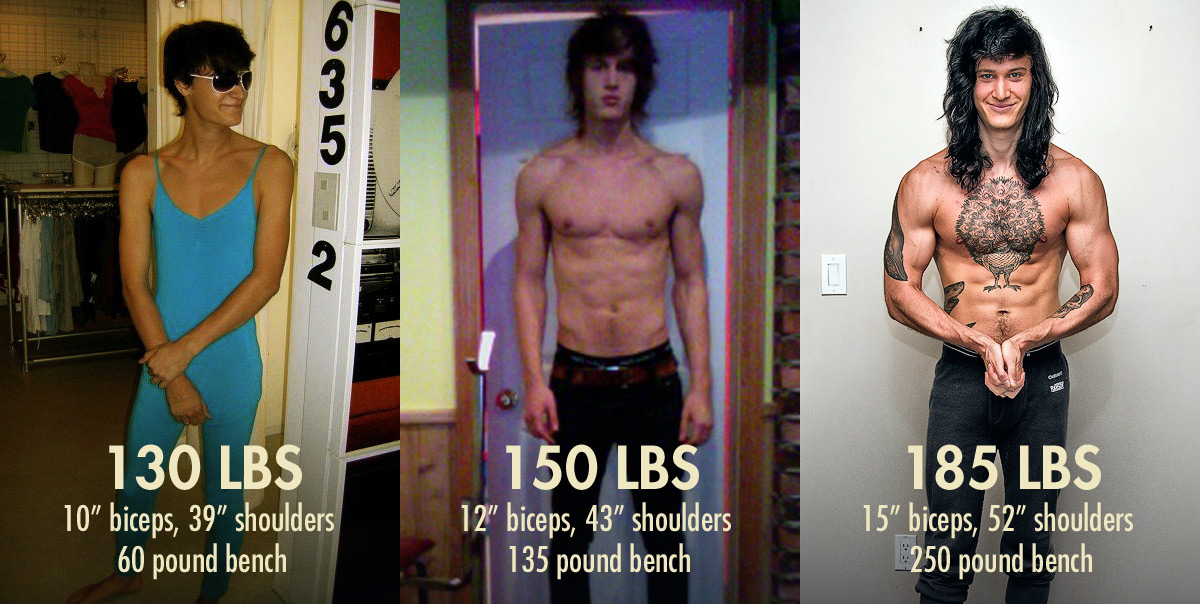
After my second year of university I got a summer job as a junior designer at a great ad agency back in my hometown of Ottawa – Canada’s friendly capital. I moved back in with my parents, and, since they were paying for groceries, I decided this would be a wonderful time to bulk up. (No supplements either, just food.) My new coworkers found it amusing, but, not counting the milk incident, they were incredibly supportive. It was a blast of a summer. I learned a lot about illustration, a lot about design and a lot about muscle. By the end of the summer I’d successfully gained 20 pounds and grown out of all of my clothes. Since then I’ve gained another 40.
I don’t want to mislead you though. The overhead lighting in my basement was pretty flattering and I’d just finished working out. Buffed up to 150 pounds I was still the smallest of all my friends:

What that summer did though was show me that I could gain weight. I’d built a ton of muscle, I was exercising regularly, and I had doubled my strength. Things were good. My confidence was up, I felt great all day long, and for the first time I knew that I was able to actually do this. Not only that, I was able to do it well. 20 pounds in four months felt miraculous. I didn’t know that was possible for anyone, let alone me. Even among my friends I went from being “skinny” to being “lean” – big difference in the impression I was giving off.
After that summer I moved in with another skinny guy in my university program: Jared. A couple years later, when we graduated, the confidence and muscle I’d built that summer was what helped me convince him to be my training partner. The transformation the two of us made was what brought us to Marco’s attention, and eventually led to the creation of Bony to Beastly. (That whole story here.)
From that point on we mainly used the gym. Jared and I worked from our home office, so we looked forward to taking a break from work and heading off to the gym. (We still do.) When the gym closed down for renovations though we busted out my old rickety bench and rusty weight plates and set up a state-of-the-art office gym:

Marco’s like us, except backwards. He works at the gym as a strength and conditioning coach, so he looks forward to heading home and training alone at his home gym. It’s his muscle-building meditation time.
The point of all this is that home gyms work. They work well. Even totally crappy borderline dangerous ones like mine.
Over the years we’ve learned a lot, started up Bony to Beastly and coached hundreds of guys into each gaining dozens of pounds of muscle. Their success doesn’t have much to do with equipment, but rather mastery of the fundamentals of lifting and nutrition. Some guys train at home, some guys train at the gym – both work equally well. So we’ve spent a lot of time trying to intelligently figure out the absolute best way to build a badass home gym.
So how do you do it? We need to consider a few things.
Progressive Overload
The first principle we need to optimize a home gym for is progressive overload: “the gradual increase of stress placed upon the body during training.” Our physiques will slowly change and improve to meet the demands that we place on it, and our bodies, however thin, are capable of some pretty damn fearsome adaptations.
… But many of us let our bodies adapt to sitting, typing and strolling. We do it day after day, year after year, and then we get frustrated that our physique doesn’t look, feel and perform the way we want it to. If we want a strong masculine physique we’ve simply got to change the stimuli. We’ve got to get our bodies eagerly transforming to lift heavier and heavier things until we’ve got a strong stable platform that can carry around hundreds of pounds and fill out a t-shirt while doing it.
Instead of backs hunching over to bring our faces closer to a computer monitor, glutes turning off to make for better sitting platforms and shoulders internally rotating for more convenient typing … we start developing new muscle fibres, our bones become denser and heavier, our biceps swell up with glycogen (muscle fuel), blood vessels stream down our arms to improve oxygen delivery, our body fat is stretched thinner over larger and more powerful musculature, and we start becoming shaped by our muscle mass instead of our bone structure.
This makes sense intuitively – we all know that muscles grow when we stimulate them. The progressive overload part is where a lot of us fail though.
Do you remember the first time you had to use a keyboard? Maybe. Chances are, whether you can remember it or not, it was a pretty awkward time for your fingers. Your typing was definitely slow and clumsy, and you needed to carefully aim each awkward finger. Now you’re a keyboard wizard. You think of a word and your fingers nimbly and automatically make it appear on the screen.
Weightlifting isn’t so different. You start off awkward and clumsy, your lifts look a little funky and the weights you’re lifting aren’t very heavy … but eventually you become strong, athletic, healthy and muscular.
Or at least you should.
If we try to jump right to the heavy part we wind up sore, our muscles wind up beaten to a pulp, our immune system gears down, our postures collapse under the weight we’re struggling to lift … and we wind up frustrated, lazing around in bed, blowing our noses, and dreading our next workout. This isn’t the Biggest Loser. Working out shouldn’t suck.
More often than not though we mess it up the other way around: not progressively lifting heavier and heavier things. Going from 15 pushups to 60 pushups won’t make you any stronger – nothing is getting heavier. Aerobics and calisthenics (body weight exercises) are exercise, and exercise is great for your health. It’s far from worthless, don’t get me wrong, and it’s way better than doing nothing. If that’s all you can do, do it. It can also be a valuable part of a progressive overload program. The problem is that if we rely on our body weight to build muscle our workouts soon become too light and the stimulus stops being enough to make our bodies grow bigger and stronger. It works well initially, but if we’re trying to get bigger than Richard Simmons we’ve got to progressively up the heaviness.
You start slow, you make some mistakes. You start off lifting within your means and you gradually lift more and more. Over time your technique improves and you start lifting heavier and heavier weights. Each step of the way your body responds by growing bigger and badder, stronger and more stable.
So we need a piece of equipment that allows us to lift heavier and heavier over time. We aren’t trying to encourage endurance adaptations, so it’s not about doing more reps, feeling sore, feeling the burn, getting our heart rate up, aerobics, etc. We’re trying to encourage strength, size, postural and power adaptations, so this is about progressively lifting heavier.
Master the Five Fundamental Movements
We need to learn the five fundamental human movements. Marco learned these from strength and muscle legend Dan John back in the day and it really helped us make this muscle stuff a whole hell of a lot simpler.
The five movements are: the press, the pull, the hinge, the squat and the carry. That’s it.
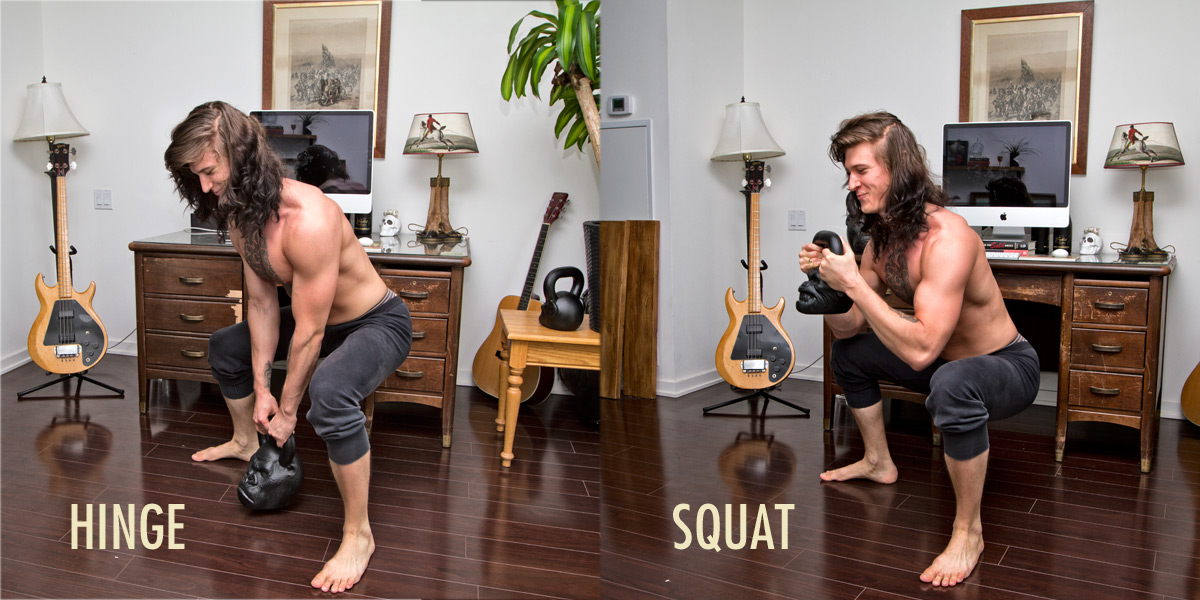
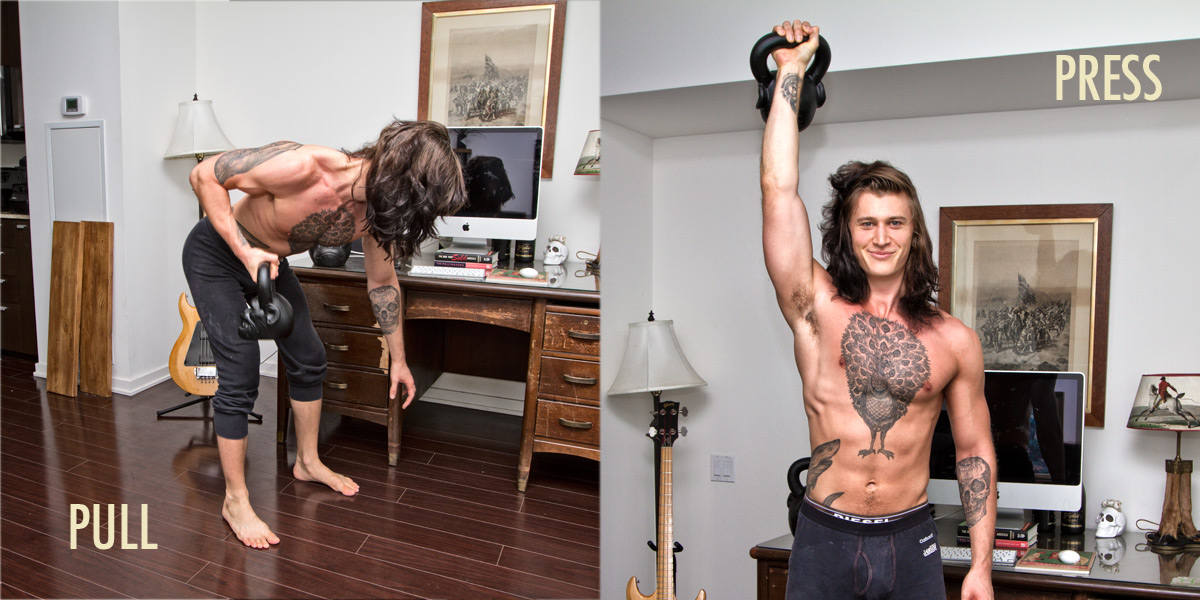
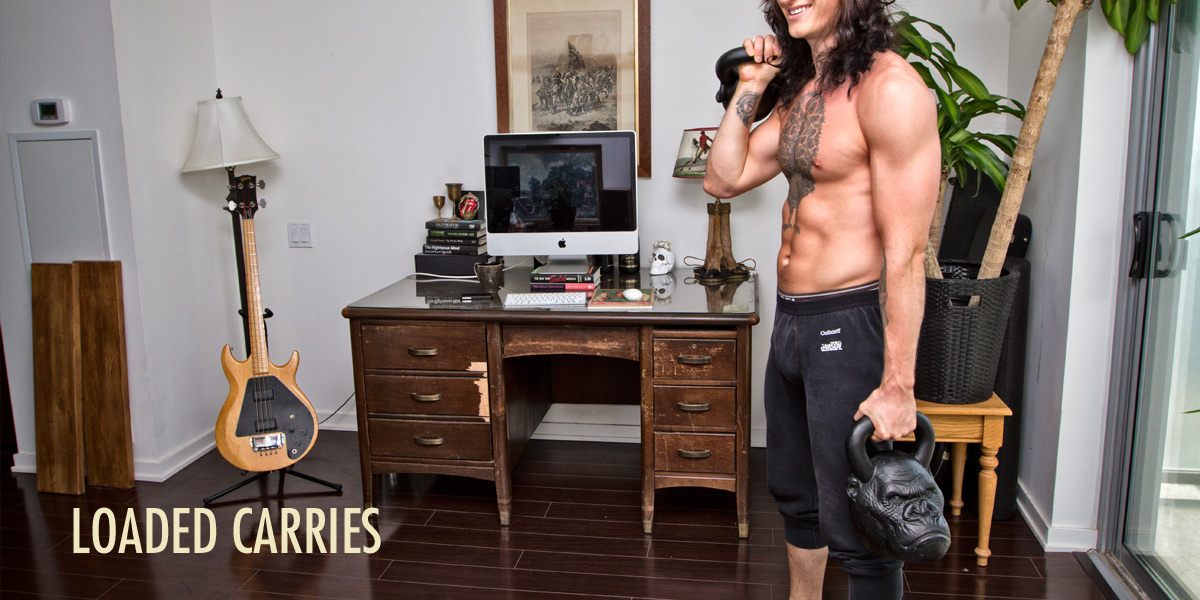
(Shown: dumbbell sumo deadlift, goblet squat, one-arm two-point supinated hinge row, one-arm press and cross carry with limited edition kettlebells.)
Presses, like the bench press, build up your shoulders, chest, triceps and abs.
Pulls, like the chin up, build up your back, shoulders, biceps, forearms and abs.
Hinges, like the deadlift, build up your back, butt, legs, abs and forearms.
Squats, like the back squat, build up your legs, abs, butt and back.
Loaded carries, well, turn you into a true beast. They build up your core, your forearms, your traps, your bones, and build up all kinds of spinal support and stability. Stuart McGill, the leading expert in spinal health, calls these a “moving plank” and considers them one of the most important tools for developing a strong body that resists injury.
The more overlap the better. You’ll see that your abs, obliques, forearms, shoulders, back and hips are getting a lot of attention. They need it. We’re teaching them how to work together in a variety of different ways. We aren’t talking about isolating muscle groups, we’re talking about getting as many of them working at once so that we can get wicked strong at the most natural human movements as effectively and efficiently as possible.
We hit every major muscle group each workout. No need to split the body up into individual body parts or find a bajillion different ways to isolate and target each different muscle fiber. As the old adage goes: the more muscle fibers involved in a lift, the more merry and muscular you’ll become. The bodybuilding split is a technique that trickled down from modern pro-bodybuilding. That’s a very very advanced and specific niche career path, not the fundamentals of becoming a genuinely and visibly strong dude whose health you can smell from a mile away.
Let’s say you’re trying to learn how to type – would it make sense to spend Monday practicing typing with just your index finger, Tuesday practicing typing with just your middle finger, Wednesday typing with just your ring finger? Obviously not. You’d want to learn how to use everything together. Not only that, you want to practice typing actual words, learning actual movement patterns and building up muscle memory so that you can do it without thinking.
That’s how you become a fearsome typist.
That’s also how you build a fearsome physique.
Just like typing, soon being a strong dude will become intuitive both in and out of the gym. When you start your lawnmower you’ll be doing a perfect pull, when you carry your groceries you’ll be doing a perfect loaded carry, when you pick up your wife and lift her over your head you’ll be doing a perfect hinge and then a perfect press.
So when it comes to building a home gym we don’t need to find ways to do cable flies and lat pulldowns, we just need to find a way to account for each of those five movement patterns. (We’ve got you covered – sit tight.)
Minimum Effective Dose
We need to find the minimal dose that’s maximally effective. The fewest number of movements that allow you to build the most muscle and strength. The fewest pieces of equipment that will allow you to do everything you need to do. That’s how you build an efficient workout, and that’s how you build a badass gym.
If you sign up to a gym you’ll have a vast array of equipment that makes all of this pretty easy (albeit slightly overwhelming and confusing). That’s great, but when we’re trying to put together a home gym we want to do the opposite: keep equipment to an absolute minimum (while still getting maximal results). This is especially important if you’re a young guy like me living in a tiny shoebox in a big city, a college kid trying to train in his bedroom or dorm room, or, well, anyone really – less space taken up by equipment means more space to move. It also saves you from wasting money on equipment you don’t need. You can buy a few high quality, safe and effective pieces of equipment and have everything you need for the rest of your life.
Safety and Simplicity
We need to make the workout safe and simple to do alone in the comfort of your home. We aren’t trying to spend six months mastering a handstand pushup so that you finally have the balance and stabilizer muscles you need to start building up your shoulders, and we aren’t trying to do experimental techniques that might throw out your back or gimp your posture. We also want to avoid being pinned under bars and dropping barbells on your head.
So, for example, what you don’t want is one of those barbell bench press benches with a rack for the barbell behind it. You know, ones like my rickety old bench.
There’s a simple reason for that: doing the barbell bench presses by yourself is sort of risky and not very effective. Not only is it impossible to take the weight off the rack using perfect form (you’d need a spotter giving you a proper hand-off) you also run the risk of not being able to lift that barbell back up. I haven’t missed a bench press ever since I stopped lifting to failure, but it took me a while to figure out my limits and how to stay within them. Even now I still always use a spotter. (Thanks Jared.)
Back in the day when I was furiously training away in my parents’ basement using my rickety old side-of-the-road bench, I got trapped under the barbell a couple times and had to shout for my little sister. The first time she promptly dropped her Harry Potter novel and came sprinting down the stairs to help me get it off. The second time she put her book down carefully and jogged down the stairs. The third time she started to realize that she was the bright one in the family … but she still saved me. That’s what little sisters are for after all, right? The fourth time she wasn’t home and I had a horrible time getting the damn thing off.
I also have to admit that the bench kind of scared me. I was never sure if it would collapse under my weight (although admittedly I didn’t weigh very much) and I was never very certain that I’d be able to safely rack the barbell. I was a long lanky dude with very little control over my limbs. That was a really bad idea. I was lucky that I didn’t drop it on my head while trying to put the barbell back on the rack. That little barbell holder thing was pretty small and I nearly missed many times.
(If you don’t take my advice and do barbell bench presses at home anyway, don’t put clamps on the barbell to hold the weights in place. That way if you wind up pinned under the bar you can dump the plates off to the side without having to shout for help. This is especially important if you don’t have a little sister.)
So we need a gym that let’s us lift heavy with minimal equipment – safely.
With all of that in mind, here’s how to build a beastly home gym:
Get a Big Heavy Adjustable Dumbbell
So what’s the absolute simplest piece of equipment that allows us to effectively, safely and progressively overload our muscles through the five fundamental movements?
A really damn heavy adjustable dumbbell or, even better, a pair of them.
You can start light and progressively load them up heavier and heavier each week. You can safely drop them if you get stuck. You can build up tons of lean mass.
Some lifts you can do with just a couple dumbbells:
The Press: Floor Press, Half-Kneeling Press, Pushups, Tricep Extensions
The Pull: Hinge Row, Bicep Curl, Hammer Curl
The Hinge: Dumbbell Sumo Deadlift, Suitcase Deadlift, Romanian Deadlift, Swings
The Squat: Goblet Squat, Split squat, Lunges (backwards)
The Carry: One-Arm Farmer Carry, Racked Carry, Cross Carry, Waiter carry
What I’d get: Badass & Basic Adjustable Dumbbells (100lbs each)
Fancier: An Expensive Adjustable Dumbbell (90lbs – single)
At this stage in the game that’s everything you need to progressively build up a bigger and more muscular physique.
You can 100% follow a fully periodized and expertly put together muscle-building program with a set of dumbbells – you just have to strip the routine down to the five fundamental human movements. So if your plan calls for a back squat or a leg press you can just sub in a goblet squat. A pair of dumbbells definitely allows you to do our Bony to Beastly Program.
(If you aren’t following a plan, well, that might be your issue right there.)
(These Amazon links are affiliate links, so if you purchase something after following the link we’ll get a small 4% commission, which would be sweet! If you decide to get this stuff using our links – thank you! The three of us really appreciate it.)
Upgrade: Sturdy Adjustable Bench
When that’s going well and you’re happily building muscle there will probably be a time when you’re eager to upgrade your home gym and expand on the list of exercises you can do and the range of motion that you can do them through. An adjustable bench allows you to turn your floor press into a bench press, your hinge rows into the dumbbell rows that all the guys at the gym do (aka 3-point dumbbell rows), and unlock some new badass strength lifts like the pullover.
Some of many:
The Push: Dumbbell Bench Press, Incline Bench Press, Military Press
The Pulls: Dumbbell Row, Bat Wings, Chest Supported Row, Pullovers, Prone Y’s
The Squat: Bulgarian Split Squats, Step Ups
What I’d get: a top of the line adjustable workout bench
Keep it sturdy, well proportioned and simple. You don’t need a bench with any sort of weird leg attachments or “bonus” features on it. You don’t need to be doing leg curls or anything – they’ll just get in the way. Go for quality and function, not fanciness.
They’re both sturdy as hell and can support tons of weight (700+ pounds). A lot of the benches are rickety things made for, well, I don’t know really, since they don’t support very much weight and their proportions make lifting a very awkward thing. My feet didn’t reach the ground with mine …
Upgrade: Power Cage and an Olympic Barbell
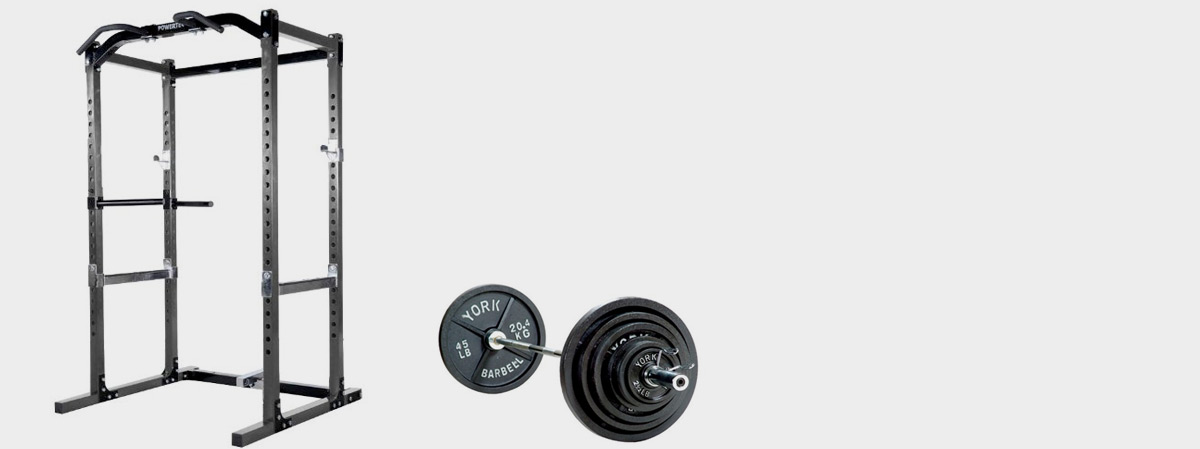
You may eventually find that you become too strong for your dumbbell setup. Even the 90 pound adjustable dumbbell that we recommend will soon become too light to dumbbell deadlift. Your legs will become so strong that your goblet squats will start to become harder on your upper body than your lower body. Plus, you may want to start adding in some cool hearty strongman lifts like the barbell (overhead) press or the Yates bent over row. Maybe down the road even some Olympic lifts. Tons of fun to be had with a barbell.
Power racks also offer you hands down the safest way to lift big weights. They’ve got safety bars, meaning that if you set it up properly they’ll be your spotter for you and safely catch any weight that you drop. You can set up your barbell bench press in there and rest assured that you won’t get pinned under the bar or drop it on your head, you can back squat without needing to worry about not being able to stand back up, etc.
A power cage and an Olympic barbell set give you absolutely 100% everything you need to train for the rest of your life. We aren’t talking about building 20-30 pounds of muscle anymore, we’re talking about building as much muscle as your frame will allow (which is probably more than you think) over the course of a lifetime.
The Push: Bench Press (with safety bars), Incline Bench Press
The Pulls: Chin Ups, Pull Ups, Yates Bent Over Row, Barbell Curls
The Hinge: Deadlifts, Rack Pulls, Romanian Deadlifts
The Squat: Front Squats, Back Squats, Box Squats
The power cage / squat rack that we recommend: The Best Power Cage
The Olympic* barbell set that we recommend: Badass Olympic Barbell Set
Both of these are top of the line pieces of equipment that you can use for decade after decade. They’ll help you lift really damn heavy really damn safely. The power cage has a chin-up and pull-up bar so you’re covered there, too.
*I highly recommend going Olympic with your barbell, even if you don’t plan on doing Olympic lifts. Olympic means that there are sleeves that rotate freely on either side of the barbell. These revolving sleeves make the barbell much easier on your grip, allowing you to lift more weight and build more muscle. “Regular” barbells don’t allow the weight plates to rotate freely, meaning the barbell will always be trying to rotate out of your grip, peeling your hands open. It’s good for your forearms … but bad for everything else you’re trying to strengthen and grow.
Bonus Gear ![How to Build a Home Gym / Home Workout – The Best Kettlebell, Ab Roller and Foam Roller]()
This is stuff that isn’t even remotely necessary, but hey if you love lifting and want to take it to the next level this stuff can be great to have around. It’s also great if you prefer training at the gym but like having a couple small pieces of equipment around home so that you can still do quick super efficient workouts when you can’t make it to the gym.
An Ab Wheel (with free washboard!). There are many many ways to functionally train you core, but for guys who have mastered the plank and who want to encourage a bit more abdominal hypertrophy and build up truly fearsome core strength, all without stressing their back or ruining their posture with crunches … this thing is super effective and super duper cheap. It’s not necessary at all, but it’s almost as fun as barbell curls.
A Kettlebell. If you’ve got an adjustable dumbbell you can technically do all the kettlebell moves: dumbbell swings, dumbbell turkish get ups, etc … but they’re kind of awkward. Adjustable dumbbells aren’t the prettiest or most streamlined things out there and you never know if a clamp will shake lose, so it can be nice to have a simple little cast iron hunk of metal with a handle on it for when you’re looking to get a little more explosive. I recommend 20 pounds and 50 pounds for starters … or you could get limited edition chimp and gorilla ones like Marco and I have (36 and 72 pounds).
A Foam Roller. I love these things. If you’ve got any kind of muscle soreness, mobility issues or you just really dig massages this is a pretty good purchase. They reduce arterial stiffness and thus may improve cardiovascular health (study), they may increase your range of motion without reducing your muscular power (study), and they increase flexibility without reducing muscular strength (study). Since static stretching can reduce power and strength output if you do them pre-workout, this makes foam rolling a wicked way to warm up. (You can use it whenever as a massage and to reduce arterial stiffness, but the mobility you gain is temporary – it won’t become permanent unless you also build strength through that range of motion, e.g., by lifting weights through the five fundamental movements afterwards.)
A Pre-Workout-Drink Home Brewery Kit: Nothing makes for a better training session than a freshly brewed pot of coffee – and you don’t need even need Starbucks! (Although the caffeine content in their drinks is wild, and caffeine is a pretty powerful ergogenic, i.e., performance enhancing, stimulant.)
I’m actually not entirely joking with this one either. Sometimes when you’re training at home it helps to build a ritual around it. You may find yourself saying “well I know I should train for an hour today … but I dunno work was kinda like long and stuff and I’m kind of tired.” It happens to the best of us, so it helps to stack the odds in our favour.
If you train in the morning lay out your training clothes at the foot of your bed. When you wake up, go have a hot shower to warm up your muscles and a hot cup of coffee to get your energy levels up. Then put on some up-tempo music to increase your training performance (study) and get to training.
If you train after work same thing – create a ritual around your workouts. Brew yourself a nice cup of coffee when you get home, maybe watch a couple training videos to get in the right head space, foam roll your muscles to get some blood flowing and loosen yourself up, put on some loud music and really get into the zone for that 45-60 minutes that you’ve set aside.
Conclusion
You don’t need to get fancy, you just need to get smart. If you stick with heartily made quality pieces of equipment, like the ones we’ve recommended, you really can’t go wrong. These things don’t ever go out of style and they don’t break, so 20 years from now if you decide to sell them instead of giving them to your kids, well, you can.
Here are the links again all in one place:
Must have: Badass & Basic Adjustable Dumbbells (or a Fancy Dumbbell)
Should have: A Sturdily Built Adjustable Workout Bench (or Cheaper)
For the lifelong lifters: A Quality Power Cage and a Classic Olympic Barbell Set
Totally optional: Foam Roller, Kettlebell and Ab Wheel
Check for some secondhand options first! You might get lucky.
And there you have it! You now know exactly how to build a home gym that will allow you to build all kinds of muscle and strength, improve your posture, improve your health, improve your cardiovascular health and performance, and look pretty damn strong and impressive.


